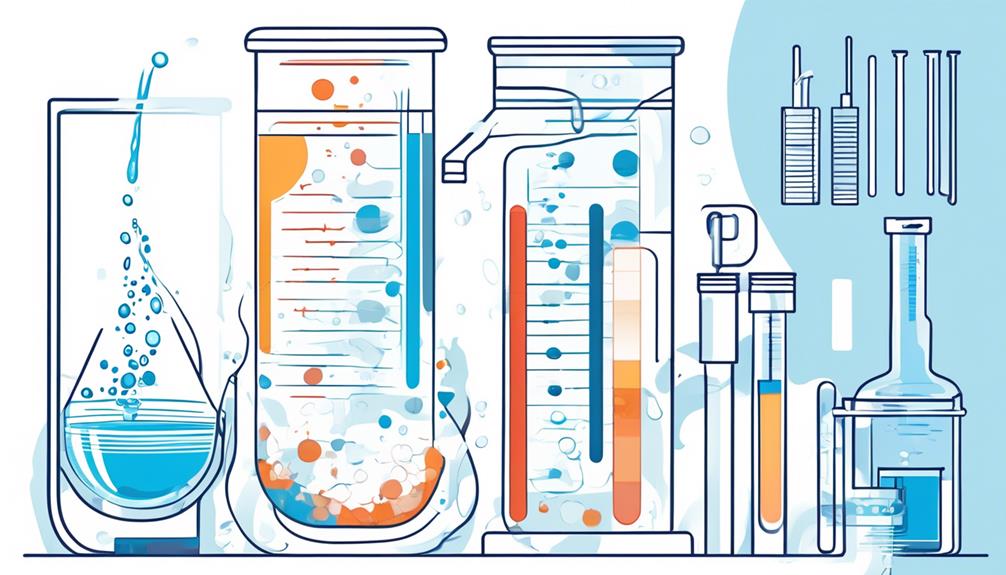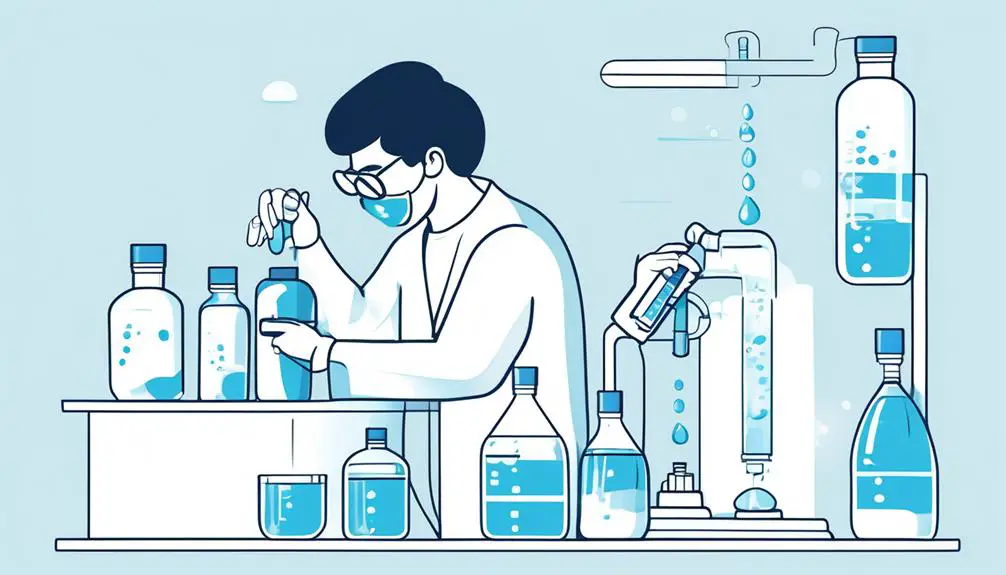Imagine waking up one morning to find your water looking slightly discolored and smelling strange. You start to wonder if it's safe to drink.
Understanding the quality parameters of drinking water can shed light on potential issues that may affect your health and well-being. By knowing how to evaluate these parameters, you can make informed decisions about the water you consume daily.
Key Takeaways
- Monitoring physical water quality parameters like turbidity, temperature, taste, and odor is essential for assessing water safety.
- Understanding common chemical contaminants such as atrazine, benzene, lead, and nitrates helps in identifying potential health risks.
- Biological water quality parameters, including bacteria, viruses, algae, and organic matter, play a significant role in determining water suitability.
- Regular water analysis reports and health risk assessments are crucial for evaluating drinking water quality and ensuring safe consumption.
Physical Water Quality Parameters
When assessing physical water quality parameters, it's essential to consider factors like turbidity, temperature, color, taste, odor, and solids to ensure the water meets safety standards and supports aquatic life.
Turbidity, influenced by silt and organic materials, impacts water treatment and aquatic habitats. Temperature plays a crucial role in water quality, with the ideal range falling between 50-60 degrees Fahrenheit.
Color variations, caused by organic and inorganic matter, are measured using color glass disks and graded on a scale of 0-70 color units. Changes in taste and odor can result from foreign substances in water, originating from sources like organic materials and dissolved gases.
Solids, whether in suspension or solution, are vital indicators of water quality, with total dissolved solids revealing the presence of organic matter and categorized into freshwater, brackish water, and saline water. Proper assessment of these parameters is key to understanding water quality, ensuring safety from contaminants like total coliform bacteria and maintaining suitable conditions for aquatic life.
Chemical Water Quality Parameters
Let's talk about common chemical contaminants and health-based guideline values in water quality assessment.
Knowing the levels of substances like lead, arsenic, and nitrates is crucial to ensure safe drinking water.
Understanding these contaminants and their permissible limits is essential to protect public health.
Common Chemical Contaminants
Understanding common chemical contaminants in drinking water is essential for assessing and maintaining water quality standards. Common chemical contaminants include atrazine, benzene, lead, nitrates, total coliform, and radon. These contaminants can have health effects and must be monitored within acceptable limits. Here is a table summarizing some common chemical contaminants found in drinking water:
| Contaminant | Health Effects | Legal Limits |
|---|---|---|
| Atrazine | Cancer risk | EPA regulated |
| Benzene | Blood disorders | Safe Drinking Water Act |
| Lead | Developmental issues | EPA regulated |
| Nitrates | Methemoglobinemia | Safe Drinking Water Act |
| Radon | Lung cancer | EPA regulated |
Health-Based Guideline Values
To ensure safe drinking water quality, it's crucial to consider Health-Based Guideline Values (HBGVs) for chemical contaminants such as atrazine, benzene, lead, nitrates, total coliform, and radon. These values help measure the level of contaminants in water, ensuring they're within acceptable limits for human health.
By testing water quality against these guidelines, you can safeguard against potential health risks associated with dissolved oxygen, parts per million, and contaminant levels. Understanding and adhering to these HBGVs is essential in maintaining the health and well-being of individuals who rely on clean and safe drinking water.
Make sure to regularly monitor and manage water quality to meet these health-based standards and protect public health.
Biological Water Quality Parameters
Monitoring biological parameters in drinking water is essential for ensuring its safety and protecting public health. When evaluating the biological water quality parameters, consider the following key points:
- Bacteria and Viruses: Presence of harmful bacteria and viruses can lead to waterborne diseases.
- Algae: Algal blooms can indicate excessive nutrient levels and affect water quality.
- Organic Matter: High levels of organic matter can impact water taste and odor.
- Aquatic Plants: Presence of certain aquatic plants may indicate nutrient pollution.
- Suspended Solids: High levels of suspended solids can reduce water clarity and quality.
Key Factors in Water Quality Evaluation
Utilizing key factors in water quality evaluation is crucial for assessing the safety and cleanliness of drinking water. When evaluating water quality, it's essential to consider a range of parameters. Physical parameters like total dissolved solids, turbidity, and temperature provide valuable insights into the water's overall quality.
Chemical characteristics such as pH, hardness, and chlorine levels play a significant role in determining water safety. Monitoring biological parameters like bacteria and viruses is essential for identifying potential health risks. Water analysis reports offer detailed information on contaminants and their concentrations, aiding in understanding water quality.
Health risk assessments are vital in determining the suitability of water for consumption. By considering these key factors in water quality evaluation, you can ensure that necessary water treatment and pollution solutions are implemented to safeguard public health and the environment. Understanding the parameters of water, including its hardness and chemical characteristics, is paramount in maintaining clean and safe drinking water.
Understanding Drinking Water Standards

Considering the essential factors in water quality evaluation, understanding drinking water standards is crucial for ensuring the safety and cleanliness of the water you consume. Here are some key points to help you grasp the significance of drinking water standards:
- Lab Report Details: The lab report includes a list of contaminants, concentrations, units, and any contaminants exceeding standards.
- Health Risk Parameters: Parameters like atrazine, benzene, lead, nitrates, total coliform, and radon are crucial in water testing.
- Regulated Contaminants: It's vital to comprehend regulated contaminants, their acceptable limits, sources, and health effects.
- Water Quality Indicators: Monitoring indicators like pH, turbidity, and total dissolved solids aids in assessing water quality.
- Importance of Compliance: Adhering to standards set by organizations such as the Environmental Protection Agency ensures the water you consume is safe.
Understanding these standards is essential for maintaining the quality of water in your household, whether for drinking, cooking, or using in water systems like heaters and softeners.
Interpreting Water Quality Test Results
When evaluating water quality test results, understanding the concentrations in mg/l or ppm is key to ensuring the safety of your water. These measurements help in determining the presence of various water quality parameters such as acidic water, high mineral content, high Total Dissolved Solids (TDS), and conductivity of water. For instance, acidic water may indicate corrosion issues, while high mineral content can affect taste and create scale buildup.
The measurements are typically reported in parts per million (ppm) or parts per billion (ppb), which are equivalent to mg/l. It's crucial to interpret these values correctly to identify any potential concerns with your water quality. Online tools can assist in evaluating the results, and referencing example water analysis reports can provide guidance.
Keeping track of these parameters over time can help in monitoring any changes and ensuring that your water remains safe for consumption.
Importance of Regular Water Quality Monitoring

Regularly monitoring the quality of your water is crucial for ensuring the safety and health of all who consume it. Here's why it's important:
- Early Detection: Monitoring helps in the early identification of any changes or contamination in the water supply.
- Issue Identification: It assists in pinpointing potential problems, enabling prompt preventive or corrective actions.
- Regulatory Compliance: Regular monitoring ensures adherence to regulatory standards and guidelines for safe drinking water.
- Data Insights: Monitoring provides valuable data for understanding long-term trends and patterns in water quality.
- Consumer Safety: Ultimately, regular monitoring is key to safeguarding the health and well-being of all individuals who rely on the drinking water supply.
Frequently Asked Questions
What Are the Parameters to Check Drinking Water Quality?
To check drinking water quality, you should look at parameters like pH, turbidity, chlorine levels, and bacteria count. These factors help ensure your water is safe and clean for consumption. Regular testing is essential.
How Do You Analyze Water Quality Parameters?
To analyze water quality parameters, you test samples for things like pH, turbidity, and bacteria. Use tools like test strips, meters, and kits. Follow guidelines, record results, and compare against standards to ensure safe drinking water.
What Are the 5 Main Ways of Assessing Water Quality?
So, you want to know how to assess water quality? Well, you can test it for pH levels, turbidity, dissolved oxygen, temperature, and presence of contaminants. These methods give you a clear picture.
How Would You Evaluate the Quality of Your Drinking Water?
To evaluate your drinking water quality, start by testing for physical, chemical, and biological parameters. Check for turbidity, pH, bacteria, and more. Understand your water analysis report to know about contaminants, legal limits, and health risks.
Conclusion
So there you have it – understanding and monitoring water quality parameters is essential for ensuring safe drinking water.
Did you know that according to the World Health Organization, over 2 billion people worldwide lack access to clean water at home?
By regularly testing and evaluating water quality, we can work towards providing clean and safe drinking water for all.
Stay informed, stay proactive, and let's make a difference together!
